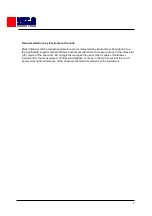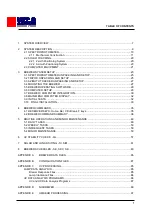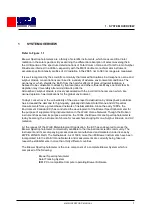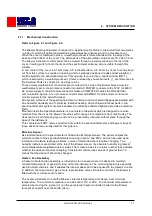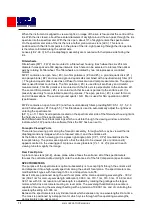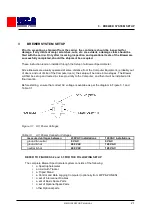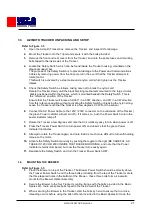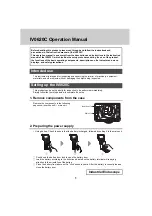
MKIII OPERATOR'S MANUAL
16
When the instrument is aligned to view sunlight, an image of the sun is focused at the centre of the
iris. With the iris closed, about three solar diameters of skylight around the sun pass through the iris
aperture into the spectrometer. With the iris open, about 10° of skylight enters the spectrometer.
On the spectrometer side of the iris there is another plano-convex lens [LE 3]. This lens is
positioned such that its focal point is in the plane of the iris. Light passing through the iris aperture
is therefore collimated along the optical axis.
Lenses [LE 2, LE 3] in the iris-diaphragm assembly are mounted with their plane side facing the
iris.
Filterwheels
Filterwheels [FW 1, FW 2] are mounted in a filter-wheel housing. Each wheel has six 25.4mm
diameter holes spaced at 60 degree intervals. Each hole can be selected to intersect the optical
axis by rotating its filterwheel. The filterwheels are rotated by two microprocessor controlled
motors.
FW #1 contains one open hole ( #3 ), two film polarizers ( #0 and #5 ), a ground-quartz disk ( #1 ),
an opaque blank ( #2 ) and a second ground quartz disk combined with a neutral density filter ( #4
). The ground-quartz disk is used as a diffuser for direct-sun and lamp measurements. The opaque
disk is used for dark count tests. The film polarizer ( #0 ) is used for all zenith sky and Umkehr
measurements. This film polarizer is mounted such that its axis is perpedicular to the entrance slit.
The second film polarizer ( #5 ) is mounted such that its axis is parallel to the entrance slit. It is
presently used only for specialized research purposes. The open position ( #3 ) is used for moon
and UV observations. The second ground quartz / N.D. filter is used for NO
2
operation on MKIV
type Brewers.
FW #2 contains an open hole ( #0 ) and five neutral-density filters providing ND=0.5, 1.0, 1.5, 2.0
and 2.5 attenuation ( #1 through 5 ). This filterwheel is used to automatically adjust the light level
entering the spectrometer.
[AP 1], an 11.18mm fixed aperture located on the spectrometer side of the filterwheel housing limits
the field-of-view of the spectrometer to f/6.
Both Filterwheels have black markings which are visible through the viewing window, and which
indicate which FW position the software thinks the FW has been set to.
Foreoptic Viewing Ports
There are two viewing ports along the foreoptic assembly, through which may be viewed the iris
diaphragm and any images which are focused onto it, and the entrance slit.
At the bottom of each viewing port is a glass right-angle prism [VP 1, VP 2] mounted inside the
foreoptic tubing. The prisms are aligned so that the object to be viewed (iris or entrance slit)
appears centred in the viewing port. A plano-convex glass lens [VL 1, VL 2] is placed in each
viewing tube to magnify the image.
Rear Fore-Optics.
A plano convex lens [LE-4], whose plane suface faces the entrance slit of the spectrometers
focuses the collimated ultraviolet light onto the entrance slit of the first (dispersion) spectrometer.
SPECTROMETERS
The purpose of the spectrometers optical subassembly is to accept light through the entrance slit
and disperse it into a high-quality spectrum along the exit-slit focal plane. The spectrometers are
modified Ebert types with focal length 16 cm, and aperture ratio f/6.
Six exit slits are positioned along the exit focal plane at the Ozone operating wavelengths - 303.2
nm (302.1 nm for mercury-wavelength calibration), 306.3 nm, 310.1 nm, 313.5 nm, 316.8 nm and
320.1 nm with 0.6 nm resolution. Wavelength is adjusted by rotating the gratings with stepper
motors which drive micrometers acting on lever arms. The wavelength-calibration procedure is
capable of measuring the wavelength setting with a precision of 0.0001 nm, and of controlling the
wavelength setting to 0.006 nm.
Between the spectrometers is a cylindrical mask which exposes only one wavelength slit at a time.
The mask is positioned by a stepper motor which cycles through all five operating wavelengths,
approximately once per second.
Summary of Contents for Brewer Mk III
Page 1: ...Operators manual Spectrophotometer Brewer MkIII...
Page 3: ...ii...
Page 5: ...2...
Page 7: ...4...
Page 25: ...MKIII OPERATOR S MANUAL 22...
Page 29: ...MKIII OPERATOR S MANUAL 26 Figure 3 4 Brewer Spectrophotometer Tripod...
Page 63: ...MKIII OPERATOR S MANUAL 60...
Page 83: ...MKIII OPERATOR S MANUAL 80...
Page 91: ...MKIII OPERATOR S MANUAL 88...
Page 93: ...MKIII OPERATOR S MANUAL 90...
Page 97: ...MKIII OPERATOR S MANUAL 94...
Page 129: ...MKIII OPERATOR S MANUAL 126...
Page 135: ...MKIII OPERATOR S MANUAL 132...


